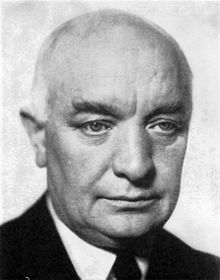Per Albin Hansson


Per Albin Hansson [ ˌpæːʁ Albin hɑːnsɔn ] (* 28. October 1885 in Malmö Fosie ; † 6. October 1946 in Stockholm ) was a Swedish politician, one "whose vision Volksheim " Sweden has had a lasting influence. The Social Democrat was Swedish Prime Minister from September 24, 1932 to June 19, 1936 and again from September 28, 1936 until his death in 1946 .
Life and politics
Per Albin Hansson came from a working-class family and grew up in Malmö. After completing four years of elementary school, Hansson started working at the age of 12. In 1903 he founded the social democratic youth association with his brother Sigfrid Hansson, of which he became chairman. In 1910, Hansson moved to Stockholm and worked for the newspaper Social Democrats . In 1918 he was elected to the Reichstag . Between 1920 and 1926 he held the post of defense minister in various governments . After Hjalmar Branting's death in 1925, he became chairman of the Swedish Social Democratic Party . In 1928 he gave his famous “ Volksheim ” speech in front of the second chamber of the Reichstag , in which he used this term to describe the goals of social democratic politics. In contrast to the previously represented Marxist policy of the SAP, Hansson relied on class reconciliation, sharp anti-communism (also within the party and within the trade union) and a socially colored patriotism. The social and political shock of the Ådalen shots (1931) strengthened his position. After the 1932 elections , Per Albin Hansson was tasked with forming a government and soon found a stable partner in the Peasant Party .
Per Albin Hansson's reign was marked by crises. The government fought the effects of the global economic crisis , which also hit Sweden in 1930, with a new labor market and agricultural policy. The comprehensive socio-political reform package that was supposed to make the dream of the “people's home” come true after 1936 fell victim to the Second World War . But Hansson's striving for cooperation across all class boundaries laid the foundation for the “ Swedish model ”. During the war he becomes a unifying figure. He managed to keep Sweden out of the war through a compliant policy of neutrality. The extradition of interned Wehrmacht members to the Soviet Union in November 1945 , known as the Baltic extradition , also took place during Hansson's reign .
After the war, the coalition government resigned and Per Albin Hansson formed a single social democratic government. In 1946 he died of a heart attack. His successor as Prime Minister was Tage Erlander . Hansson is buried on the Norra begravningsplatsen .
Honors in Vienna
In the 10th district of the Austrian capital Vienna there are three settlements named after Hansson; The naming of the Per-Albin-Hansson settlements West, North and East in 1951 is intended to remind us that in 1945 Hansson played a decisive role in initiating relief efforts for the hungry Viennese population after the Second World War . On Stockholmer Platz, from which Per-Albin-Hansson-Straße starts, there is a bust of Hansson by Emil Näsvall.
literature
- Bengt Schüllerqvist: Från kosackval till kohandel - SAPs väg till makten (1928–1933). Tidens, Stockholm 1992.
Web links
| personal data | |
|---|---|
| SURNAME | Hansson, Per Albin |
| BRIEF DESCRIPTION | Swedish politician, member of the Riksdag |
| DATE OF BIRTH | October 28, 1885 |
| PLACE OF BIRTH | Fosie near Malmö |
| DATE OF DEATH | October 6, 1946 |
| Place of death | Stockholm |

